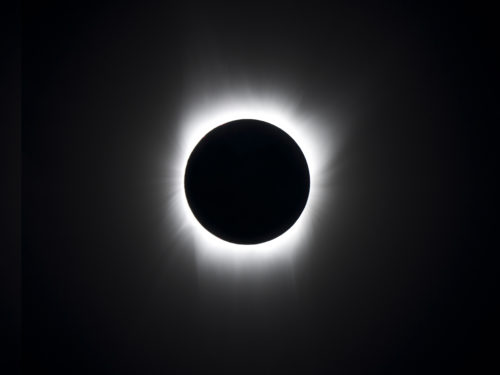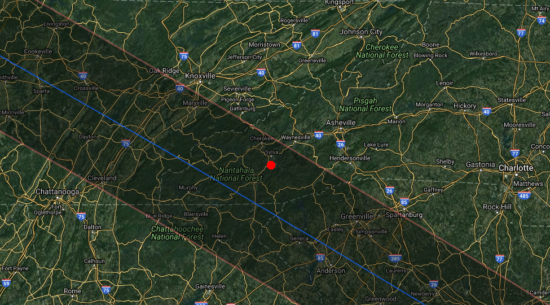For those seeking shade from the sun this week in Cullowhee, the Moon is about to offer a little help.

A NASA photo of a solar eclipse. Photo by Jay M. Pasachoff, Muzhou Lu, and Craig Malamut.
On Monday Aug. 21, the Earth, Moon and Sun will align in such a way that the Moon will completely block out the Sun’s disc in the sky in a diagonal path stretching from Salem, Oregon to Charleston, South Carolina. People are calling it the Great American Solar Eclipse.
The time when the Moon aligns almost perfectly with the Sun from the perspective of any given point on the surface of the Earth is called totality. That’s why the path that the Moon’s shadow will trace across the face of North America is called the path of totality.
Because of the shape of Monday’s path of totality, only 300 million Americans or so will witness a total eclipse. The rest of the country will experience a partial eclipse – which will look more like someone took a bite out of the Sun.
Being within the path of totality doesn’t mean your experience will be the same as everyone else’s in the shadow. The closer you are to the center of the 67-mile-wide path, the longer totality will last where you stand.
So what does that mean for eclipse viewers in or around Cullowhee?
Although we’re lucky enough to fall within the path of totality, we’re closer to the edge than the center. That means we will see the Moon completely block out the Sun, but maybe not for as long as some others. The Jackson County government predicts totality in and around Sylva to last about 1 minute and 45 seconds.
WCU Associate Professor of Astronomy and Physics, Enrique Gomez, set this timeline for the solar eclipse on campus:
1:07 p.m.: The Moon will begin to cover the Sun.
2:35 p.m.: The Moon will perfectly overlap the Sun.
2:37 p.m.: The Sun will start to peek out from behind the Moon.
4:01 p.m.: The Moon will completely uncover the Sun.

The red dot shows where WCU’s campus lies within the path of totality. Screenshot from Xavier Juber’s 2017 Total Eclipse Interactive Google Map.
According to WCU Director of Communications and Public Relations Bill Studenc, classes will not be held between 1 and 3 p.m. on Monday Aug. 21. He also said students who live on campus will be able to pick up viewing glasses during check-in to their residence halls. You can also pick up glasses the afternoon of the eclipse at tables on the UC lawn or between the Bardo Arts Center and the stadium parking lot.
There will be a viewing event at the center of campus near the fountain with platform panels on the science of the event and safe viewing techniques.
“It’s extraordinarily rare,” said Gomez. “Eclipses usually happen in remote parts of the world like the arctic or the middle of the ocean. It’s a rather unique thing because during those minutes, the sky will be dark enough to see stars and planets as well as different layers of the sun’s atmosphere that you can’t normally see – the Corona and Chromosphere.”
Many people wonder how often a full solar eclipse occurs, and there are a few different ways to answer that. According to The Old Farmer’s Almanac, although some point on the surface of the Earth falls under the shadow of the Moon every 18 months, this eclipse will be the first to substantially grace our continent in almost a century. The next time the path of totality will stretch from coast to coast will be in 2045.
As far as how often a single point on Earth experiences a solar eclipse, the average is once every 375 years, but in reality it varies and relies on chance. Cullowhee hasn’t witnessed a total solar eclipse since 1506, and it won’t again until 2153.
If you plan on viewing the solar eclipse from along the path of totality, here are some tips from NASA on doing so safely.
1.) It is safe to look at the fully eclipsed Sun, but that safe period of totality doesn’t last long.
2.) Before and after totality, you must use special-purpose solar filters. Don’t look at the Sun leading up to or right after totality unless you’re wearing eclipse glasses.
3.) Don’t use a camera or lens to view the uneclipsed Sun, even if you’re wearing eclipse glasses. The concentrated rays could penetrate the solar filter. If you plan on photographing or filming the eclipse, you’ll need a solar filter on the device itself.
If you will not be in Cullowhee for the eclipse, WCU will live stream the event starting at 2 p.m.


